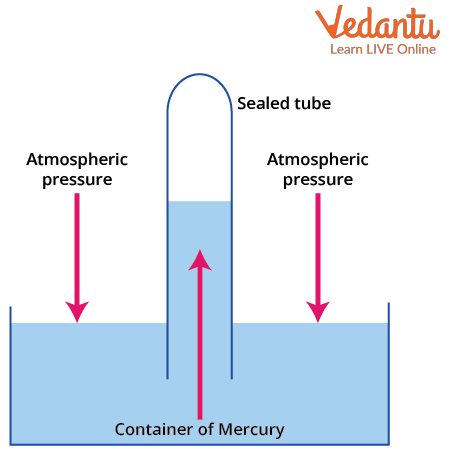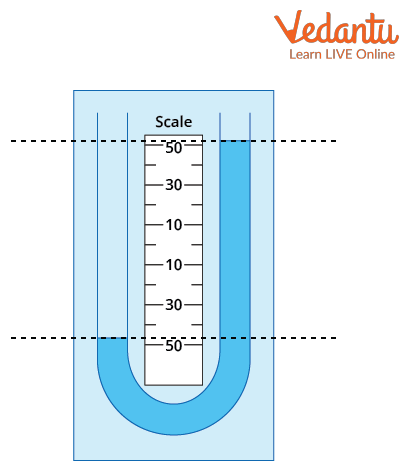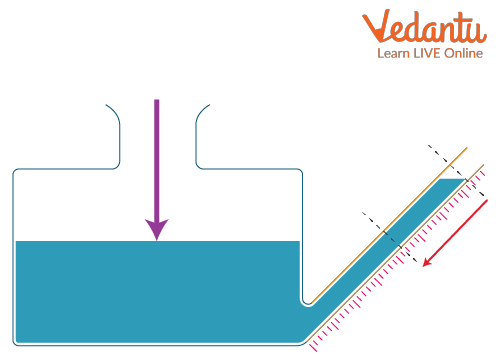




What is a Barometer and Manometer?
A scientific instrument that measures atmospheric pressure and is usually employed for forecasting weather is called a barometer. The pressure measured using a barometer is also known as the barometric pressure. A manometer on the other hand is used to measure the fluid pressure. The pressure acting on a column of fluid in a U-shaped tube causes the liquid/fluid to reach different heights of the arm due to the difference of pressure in the two arms.
Additionally, it must be known that the liquid/fluid pressure in a manometer is measured with reference to the earth’s atmosphere. Both barometer and manometer are classified into their different types which include the mercury barometer, U-tube manometer and well-type manometer, respectively.
Barometer Diagram
The barometer is predominately used for weather forecasting. The figure below is that of a mercury or a torricellian barometer. It consists of a glass tube placed upside-down in a mercury container.

A Mercury Barometer
Barometer Working Principle
The working principle of the barometer is quite simple. An inverted glass tube is placed in a container of mercury. The atmospheric pressure pushes down the mercury which causes a rise in the mercury level in the tube. This rise in the mercury level in the tube is equivalent to the amount of atmospheric pressure. The pressure at the top of the tube is zero as it consists of vacuum.
The principle of the barometer can also be explained in this way. If you fill a bowl with water and try sipping the water using a straw, by applying pressure on the straw the water level in the straw increases. By sipping water using a straw we are actually drawing out the air from the straw. Also, the air pushes down the water and forces it to move up the straw.
Thus, the working of a barometer simply relies on the principle of balance. Aneroid barometer is another type of barometer that is used to measure the atmospheric pressure. The word aneroid means without water, thus there is no fluid or water involved in the pressure measurements. Unlike the mercury barometer, the aneroid barometer is made up of a flexible material box which is also called a vacuum chamber or a capsule. This vacuum chamber or capsule is made up of an alloy of copper and beryllium.

An Aneroid Barometer

Working of an Aneroid Barometer
An aneroid barometer consists of a metal cell or a capsule with flexible sides. Whenever there is a change in the atmospheric pressure, it causes a change in the sides of the capsule. This movement is transmitted to the pointer at the face of the aneroid barometer with the mechanism of pulleys and levers.
Manometer Diagram
Manometer is one of the oldest pressure measurement devices. It is used to measure the pipe fluid flow pressure, gas pressure, and so on.

Image of a U-tube Manometer
Manometer Working Principle
The manometer works on the principle that changes in pressure will cause the liquid to rise or fall in a tube. Manometers are further classified into a U-tube shaped manometer and an inclined manometer. Manometers usually employ a fluid to measure the pressure. Mercury, water, or any light weight fluid (or light oils) can be used in a manometer. The need for using other fluids is due to the harmful impact of mercury on the environment.
When the pressure in the U-tube type manometer is equal, the mercury level is at the same height. Alternatively, if the pressure is unknown, it causes a differential pressure in the two arms of the U-shaped tube.
The accuracy of a manometer can be further increased with an inclined manometer. Below is a visual representation of an inclined manometer. It consists of a container filled with mercury with a transparent column inclined at an angle. The rise or fall in mercury in the column is a measure of the pressure.

Inclined Manometer
Differences between the Barometer and Manometer
From the table given below, we can differentiate between a Barometer and a Manometer.
Conclusion
Manometers and barometers are two fundamental devices that are used to measure pressure. Barometers are used to measure atmospheric pressure above and below seal levels whereas manometers measure fluid pressure. The two are frequently used for weather forecasting and other applications. Both the devices come in different configurations such as U-tube type manometer and inverted column barometer and so on. The article summarised the working principle of both the devices, followed by the constructional details and their applications.






FAQs on Barometer and Manometer and Their Working Principle for JEE
1. Why is water not much preferred as a liquid in a barometer?
As water’s density is lower than mercury, it cannot be used as a barometric liquid. If we use water as a barometric fluid, the length of the column required would be very high as compared to when using mercury as a barometric liquid. Water’s density is
2. What is an altimeter and how does it differ from a barometer?
As the name suggests, an Altimeter measures altitude but it actually measures air pressure. Now, we know there’s a well-understood relationship between air pressure at altitude. As altitude increases, the air pressure decreases. A barometer measures the air pressure in kiloPascals (kPa), whereas an altimeter will measure the altitude in feet or metres. Altimeters are further classified into sonic and radar altimeters. Instead of using air pressure, one uses a radiopulse and the measure acoustically to measure the height above the ground.












